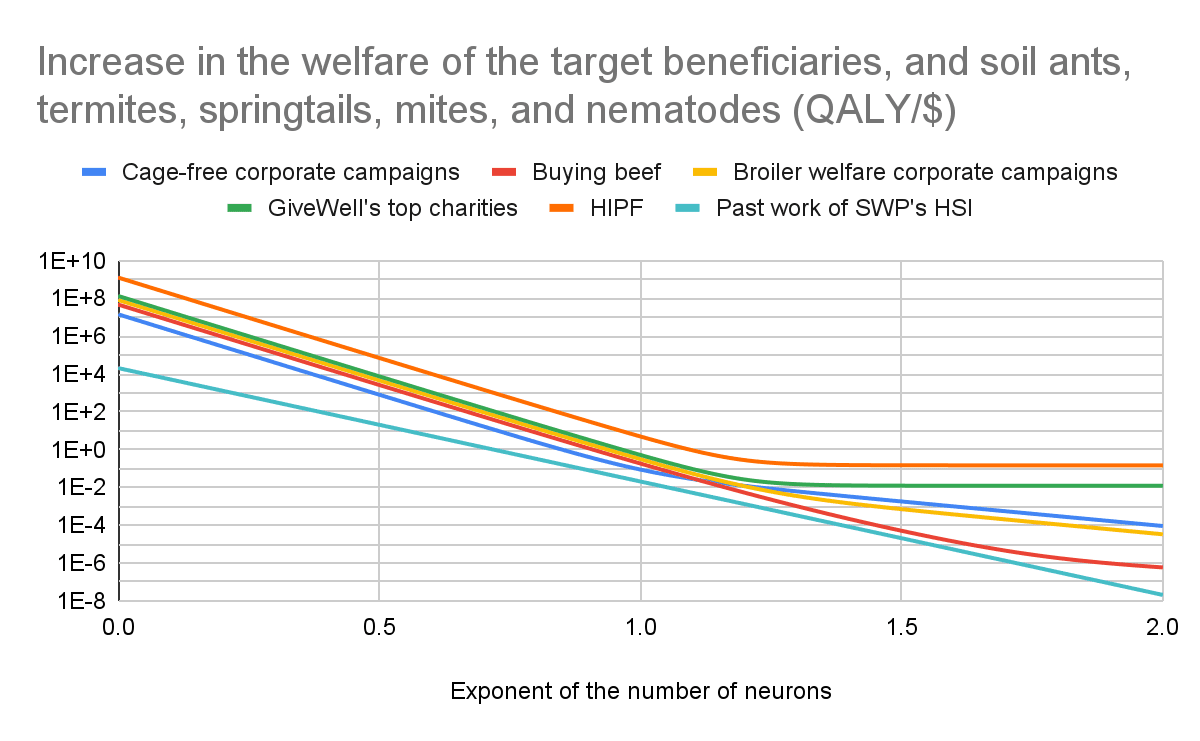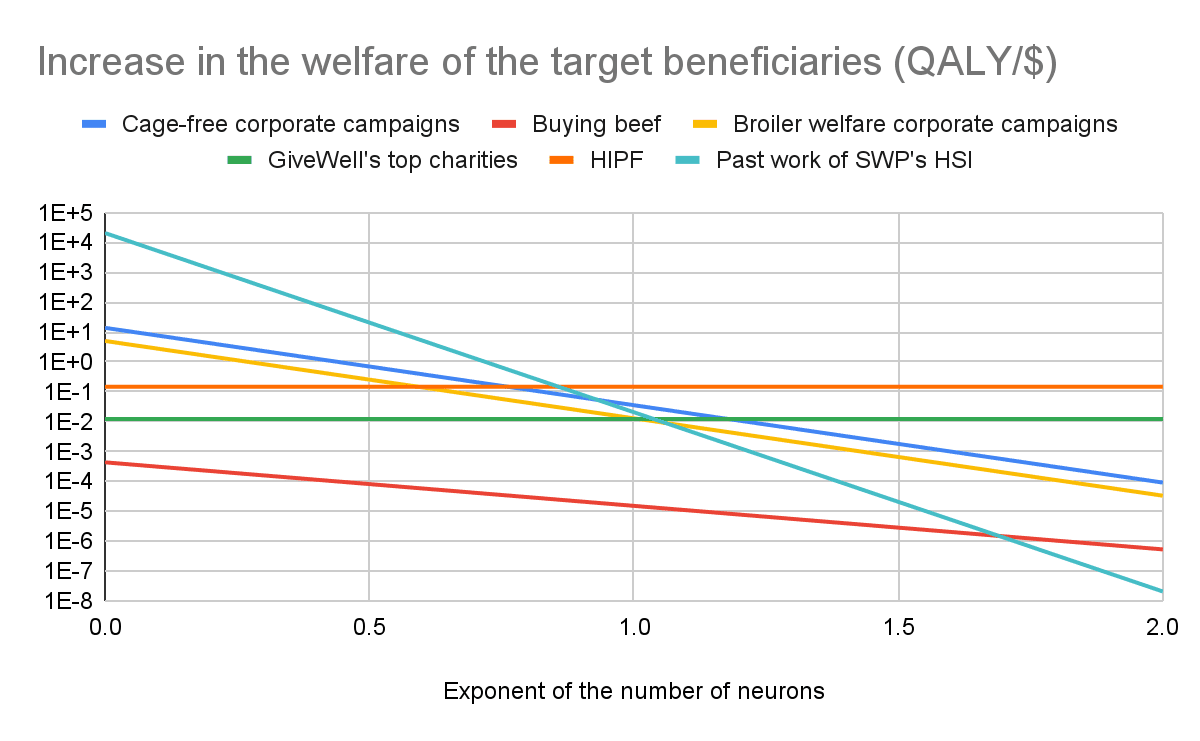Vasco Grilo🔸
Bio
Participation4
I am a generalist quantitative researcher. I am open to volunteering and paid work. I welcome suggestions for posts. You can give me feedback here (anonymously or not).
How others can help me
I am open to volunteering and paid work (I usually ask for 20 $/h). I welcome suggestions for posts. You can give me feedback here (anonymously or not).
How I can help others
I can help with career advice, prioritisation, and quantitative analyses.
Posts 214
Comments2652
Topic contributions36
Hi Abraham.
I think the opportunity for impact for wild animal welfare is way bigger, and it's much more "normal"
I agree the absolute value of the total welfare of wild animals is much larger than that of farmed animals. On the other hand, the most popular opportunities to help wild animals focus on ones which only account for a small fraction of the total welfare of wild animals (although I think they change the welfare of soil animals much more). In extreme cases, such opportunitites would only improve the welfare of a few wild mammals to avoid the extinction of species. Of course, this is not the target of the Center for Wild Animal Welfare (CWAW), or Wild Animal Initiative (WAI). However, I still wonder about whether CWAW and WAI are focussing too much on what is popular, and underfunding research informing how to increase the welfare of (wild) soil animals. I currently think funding the Arthropoda Foundation is the best option for this. Mal Graham, who together with Bob Fischer "make[s] most of the strategic and granting decisions for Arthropoda", mentioned "We collaborate with Wild Animal Initiative (I’m the strategy director at WAI) to reduce duplication of effort, and have a slightly better public profile for running soil invertebrate studies, so we expect it will generally be Arthropoda rather than WAI who would be more likely to run this kind of program".
Thanks, Cody.
will AGI systems become so cheap to run and scalable that they will make it unviable to instead pay a human to do any work?
It is not enough for AIs to be better than humans at jobs defined in an overly narrow sense. Chess engines are much cheaper to run, and play much better than top chess human players, but these still have jobs.
It's possible AGI will never become cheap and scalable enough for this to happen, but Tabarrok doesn't ever really make an argument that this is so.
I agree Maxwell does not make that argument. On the other hand, humans eventually running out of jobs is not necessarily bad either. Huge automation would increase wealth per capita a lot, and this has been associated with improvements in human welfare per capita throughout history.
Thanks, Matt. I agree. However, "If AIs are a perfect substitute for humans" is a very big if. In particular, it is not enough for AIs to be better than humans at jobs defined in an overly narrow sense. Chess engines are much cheaper to run, and play much better than top chess human players, but these still have jobs.
Hi Nathan and Ben.
- If comparative advantage is a panacea, why are there fewer horses?
I liked Maxwell's follow-up post What About The Horses?.
The following framework explains why horses suffered complete replacement by more advanced technology and why humans are unlikely to face the same fate due to artificial intelligence.
- Humans and AIs Aren't Perfect Substitutes but Horses and Engines Were
- Technological Growth and Capital Accumulation Will Raise Human Labor Productivity; Horses Can't Use Technology or Capital
- Humans Own AIs and Will Spend the Productivity Gains on Goods and Services that Humans Can Produce
- Comparative advantage means I'm guaranteed work but not that that work will provide enough for me to eat
I agree. The last section of the post above briefly discusses this.
The argument is plausible and supported by history but it’s not a mathematical deduction. The key elements are relative productivity differences, technological improvements that increase labor productivity, and increased income generating demand for goods and services produced by humans.
[...]
Higher wages are not always and everywhere guaranteed, but humans are not likely to face the same fate as horses. We are far from perfect substitutes for AIs which means we can specialize and trade with them, raising our productivity as the AI labor force multiplies. We can take advantage of technological growth and capital accumulation to raise our productivity further. We'll continue inventing new ways to profitably integrate with automated production processes as we have in the past. And we control the abundant wealth that AI automation will create and will funnel it into human pursuits.
Also on comparative advantage, I liked Noah Smith's post Plentiful, high-paying jobs in the age of AI.
Thanks for sharing, Aaron! I like the ambition.
Do you have any thoughts on the effects of HSI on soil animals? For individual welfare per fully-happy-animal-year proportional to "number of neurons"^0.5, I estimate electrically stunning farmed shrimp changes the welfare of soil animals more than it increases the welfare of shrimps if it results in the replacement of more than 0.0374 % of the consumption of the affected farmed shrimp by farmed fish. I can easily see this happening for even a slight increase in the cost of shrimp. I do not know whether the welfare of soil animals would be increased or decreases. So it is very unclear to me whether electrically stunning shrimp increases or decreases welfare (in expectation). In any case, I do not think HSI is amongst the most cost-effective ways of increasing animal welfare. I calculate interventions targeting other farmed animals or humans change animal welfare much more cost-effectively accounting for effects on soil animals resulting from land use changes as long as individual welfare per fully-happy-animal-year is proportional to "number of neurons"^"exponent of the number of neurons", as is illustrated in the graph below. However, given the large uncertainty about the effects on soil animals ("Increase" in the graph below should be interpreted as "Change"), I recommend research informing how to increase the welfare of soil animals over pursuing whatever land use change interventions naively seem to achieve that the most cost-effectively.

Great post!
Instead of undermining pro-animal cost-effectiveness analyses with a human-favoring philosophical theory (namely, Conscious Subsystems itself), Conscious Subsystems appears to support the conclusion that there are scalable nonhuman animal-targeting interventions that are far more cost-effective than GiveWell’s recommended charities.
I estimate cage-free corporate campaigns, buying beef, broiler welfare corporate campaigns, GiveWell’s top charities, Centre for Exploratory Altruism Research’s (CEARCH’s) High Impact Philanthropy Fund (HIPF), and Shrimp Welfare Project’s (SWP’s) Humane Slaughter Initiative (HSI) increase the welfare of their target beneficiaries roughly as cost-effectively for individual welfare per animal-year proportional to the number of neurons. This is illustrated for an exponent of the number of neurons of 1 in the graph below.

This isn’t a situation where it makes sense to maximize expected utility at any given moment. Instead, we should acknowledge our uncertainty, explore related hypotheses and try to figure out whether there’s a way to make the questions empirically tractable.
Agreed.

Welcome to the EA Forum, Shloka! Thanks for the great comment. I strongly upvoted it.
I have not looked into the effects of land use change on different groups of nematodes. From Table 1 of van den Hoogen et al. (2019), which is below, the most abundant soil nematodes are bacterivores and herbivores, so I speculate effects on these are the most important. However, I agree a given land use change may increase the welfare of nematodes of a given type, but decrease that of ones of a different type. This strengthens my conclusion that the priority is research informing how to increase the welfare of soil animals, not pursuing whatever land use change interventions naively seem to achieve that the most cost-effectively.